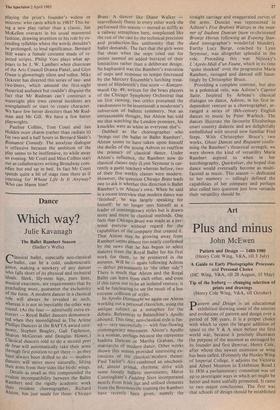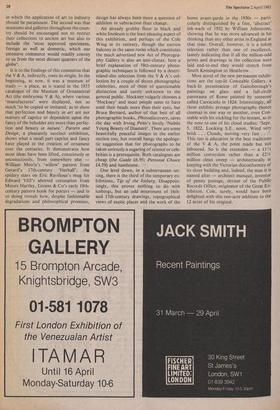Art
Plus and minus
John McEwen
Pattern and Design — 1480-1980 (Henry Cole Wing, V&A, till 3 July) A Guide to Early Photographic Processes and Personal Choice (HC Wing, V&A, till 28 August, 15 May) Tip of the Iceberg — changing selection of prints and drawings (Henry Cole Wing, V&A, till October)
plo altern and Design is an educational exhibition showing some of the sources and evolutions of pattern and design over a period of 500 years. It is a proper choice with which to open the largest addition of space to the V & A since before the first world war, because it precisely illustrates the purpose of the museum as envisaged by its founder and first director, Henry Cole, after whom this newest extension or wing has been called. (Formerly the Huxley Wing of Imperial College, it adjoins the Victoria and Albert Museum in Exhibition Road.) In 1836 a parliamentary committee was set up to investigate ways in which art might be better and more usefully promoted. It came to two major conclusions. The first was that schools of design should be established
in which the application of art to industry should be paramount. The second was that museums and galleries throughout the coun- try should be encouraged not to restrict their collections to ancient art but also to include the 'most approved specimens, foreign as well as domestic, which our extensive commerce would readily convey to us from the most distant quarters of the globe'.
It is to the findings of this committee that the V & A, indirectly, owes its origin. In the beginning, as now, it was a museum of study — a place, as is stated in the 1853 catalogue of the Museum of Ornamental Art (the embryonic V & A), where various 'manufactures' were displayed, not so much 'to be copied or imitated, as to show that perfection and beauty in art are not matters of caprice or dependent upon the fancy of the beholder any more than perfec- tion and beauty in nature.' Pattern and Design, a pleasantly succinct exhibition, shows what a small part caprice and fancy have played in the creation of ornament over the centuries. It demonstrates how most ideas have been lifted, consciously or unconsciously, from somewhere else — William Morris's 'willow' pattern from Gerard's 17th-century Herball'; the spidery stars on Eric Ravilious's mug for Edward VIII's aborted coronation from Messrs Hartley, Greens & Co's early 19th- century pattern book for potters — and in so doing reveals how, despite fashionable degradations and philosophical promises, design has always been more a question of addition or subtraction than change.
An already grubby floor in black and white linoleum is the least pleasing aspect of this exhibition, and perhaps of the Cole Wing in its entirety, though the narrow balcony in the same room which constitutes the much advertised new Art of Photogra- phy Gallery is also an anti-climax, here a brief explanation of 19th-century photo- graphic techniques is followed by a desert- island-disc selection from the V & A's col- lection by a couple of dozen photographic celebrities, most of them of questionable distinction and surely unknown to the general public. Hockney vulgarly chooses a `flockney' and most people seem to have used their heads more than their eyes, but Bruce Bernard, author of that best of all photographic books, Photodiscovery, saves the day with Irving Penn's lovely 'Nubile Young Beauty of Diamare. There are some beautifully peaceful images in the earlier section too, but overall hangs the apologe- tic suggestion that for photographs to be taken seriously a sugaring of science or cele- brities is a prerequisite. Both catalogues are cheap (the Guide £6.95; Personal Choice £4.59) and handsome.
One level down, in a subterranean set- ting, there is the third of the temporary ex- hibitions, Tip of the Iceberg. Disappoin- tingly, this proves nothing to do with icebergs, but an odd assortment of 16th- and 17th-century drawings, topographical views of exotic places and the work of the
home avant-garde in the 1930s — parti- cularly distinguished by a fine, 'abstract' ink-wash of 1932 by William Johnstone, showing that he was more advanced in his thinking than any other artist in England at that time. Overall, however, it is a token selection rather than one of excellence, lamely indicating that if all the million-odd prints and drawings in the collection were laid end-to-end they would stretch from South Kensington to Heathrow.
Most novel of the new permanent exhibi- tions are the top-lit Constable Gallery, a back-lit presentation of Gainsborough's paintings on glass and a full-circle panorama of Rome painted by someone called Carraciolo in 1824. Interestingly, all three exhibits presage photography (hence cinema) in one way or another, even Con- stable with his stickling for the instant, as in the note to one of his cloud studies: `Sept. 5. 1822. Looking S.E. noon. Wind very brisk . . . Clouds, moving very fast .
This too is educative in the best traditions of the V & A, the point made but not laboured. So is the extension — a £1 1/4 million conversion rather than a £21/4 million clean sweep — architecturally ill keeping with the Victorian disconformity of its sister building and, indeed, the man it is named after — architect manqué, inventor of penny postage, deviser of the Public Records Office, originator of the Great Ex- hibition. Cole, surely, would have been delighted with this one-acre addition to the 12 acres of his original.







































 Previous page
Previous page